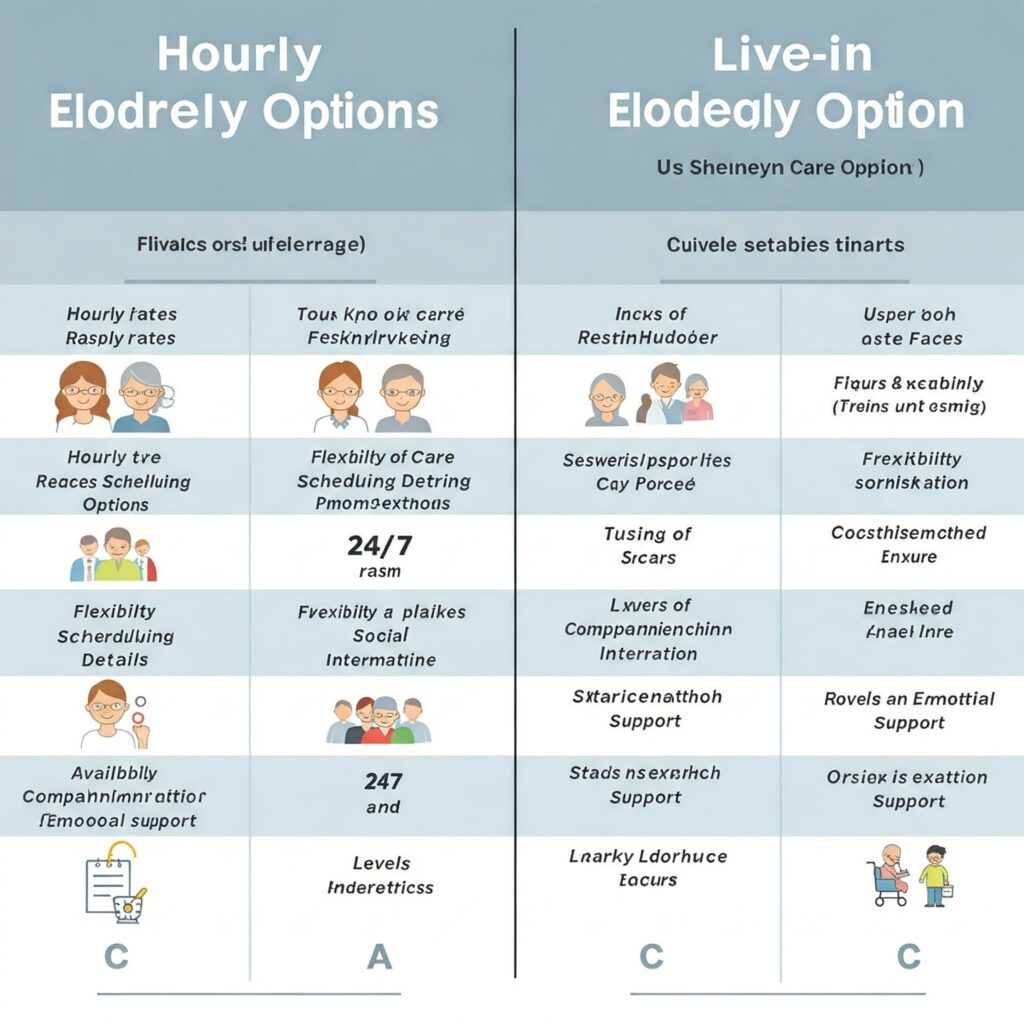Deciding on the best care for a loved one can be challenging, particularly when considering the options of hourly care versus live-in care. Both provide valuable support, but they cater to different needs and preferences. Understanding the key differences will help you make an informed choice.

What is Hourly Care?
Hourly care, also known as domiciliary or visiting care, involves a caregiver visiting your home for scheduled periods. These visits can range from a few hours a day to several times a week, depending on the individual’s needs.
- Services:
- Assistance with Activities of Daily Living (ADLs) such as bathing, dressing, and grooming.
- Help with Instrumental Activities of Daily Living (IADLs) like meal preparation, light housekeeping, and medication reminders.
- Companionship and social interaction.
- Transportation to appointments.
- Flexibility: Hourly care provides flexibility, allowing you to schedule assistance only when needed. This option works well for those who can manage independently for parts of the day but require help at specific times.
- Cost: Hourly care is generally less expensive than live-in care, as you only pay for the hours of care you receive.
What is Live-In Care?
Live-in care involves a caregiver residing in your home full-time, providing continuous support and assistance. This option is ideal for individuals with complex needs who require ongoing supervision and care throughout the day and night.
- Services:
- All services included in hourly care, but provided around-the-clock.
- 24/7 support and monitoring, particularly beneficial for those with dementia, mobility issues, or complex medical conditions.
- Companionship and emotional support at all times.
- Continuity: Live-in care offers consistency and allows for a strong relationship to develop between the caregiver and the care recipient.
- Cost: Live-in care is typically more expensive than hourly care due to the full-time nature of the service. However, it can be a cost-effective alternative to a residential care home, especially for couples, as care home fees would apply to both individuals.
Key Differences at a Glance
| Feature | Hourly Care | Live-In Care |
|---|---|---|
| Care Schedule | Scheduled visits, ranging from a few hours a day to several times a week. | 24/7 care, with a caregiver residing in the home. |
| Level of Support | Assistance with specific tasks and companionship during scheduled visits. | Continuous support, supervision, and assistance throughout the day and night. |
| Cost | Generally less expensive, as you pay only for the hours of care received. | Typically more expensive, but can be cost-effective compared to a care home. |
| Independence | Allows for greater independence as care is provided only when needed. | Provides continuous assistance for those who require more supervision. |
| Companionship | Companionship during scheduled visits. | Constant companionship and emotional support. |
| Relationship Building | May involve different caregivers, potentially impacting continuity. | Allows for a strong, consistent relationship with a dedicated caregiver. |
Export to Sheets
Which Option is Right for Your Loved One?
The best choice between hourly and live-in care depends on several factors:
- Care Needs: If your loved one requires 24/7 support, especially for complex medical needs or dementia, live-in care is often the most suitable option. If assistance is needed only at specific times, hourly care may be sufficient.
- Budget: Hourly care is generally more affordable for those with limited needs. While live-in care has a higher weekly cost, it can be more economical than 24/7 hourly care or residential care.
- Lifestyle Preferences: Some individuals value the independence that hourly care provides, while others prefer the security and companionship of a live-in caregiver.
- Companionship: Live-in care provides constant companionship which could be beneficial for individuals who feel isolated.
- Home Environment: To receive live-in care, you need a spare bedroom.
- Continuity: Live-in care promotes one-to-one care, and the same carer can be more attuned to changes in the patient’s condition.
It’s crucial to discuss your loved one’s needs and preferences with healthcare professionals and home care agencies to determine the most appropriate care plan.
Would you like more information about either hourly or live-in care?
